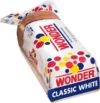For some reason all the breads in the grocery store have a list of ingredients longer than necessary. What’s wrong with just using the basics: Flour, water, salt, and yeast – like this simple bread recipe.
Bread seems like such a simple thing. We took a survey of 100 common store breads and listings of their ingredients.
See the full list of breads here.
Ingredient lists are an interesting thing to me… They are a sort of window into a manufacturers intentions. Are the ingredients in there for the purpose of making the bread more healthy and nutritious, or to help the manufacturer make more money?
It seemed like this list would be interesting because you can choose an ingredient, and see all the breads that contain that particular ingredient.
For example you can see all the breads in our survey that have strange ingredients like “DATEM” (diacetyl tartaric acid ester of mono- and diglycerides, also known as E472e) See our list of breads with DATEM here.
I don’t believe any customers have ever asked manufacturers to add DATEM to their bread. Maybe they do like it spongy and spring but I believe there are other ways to achieve those qualities in bread. According to the DATEM wikipedia article, it is a dough conditioner and makes dough spongy and springy, ok… I’m guessing It’s not in there for the benefit of the customer, it’s in there to help the manufacturer profit.
According to this “Is It Bad For You” entry on DATEM:
Although the FDA has determined that DATEM is safe for consumption, studies from other various sources are concluding that DATEM should be avoided. DATEM has been found to heart fibrosis and adrenal overgrowth in lab animals.
Or breads containing High Fructose Corn Syrup or Soybean Oil.
Maybe we will do this with some more foods and products in the future. For example some foods contain some of the same ingredients found in antifreeze / engine coolant. It would be interesting to see them in a list together.
For example, Propylene Glycol from Wikipedia:
Propylene glycol is considerably less toxic than ethylene glycol and may be labeled as “non-toxic antifreeze”. It is used as antifreeze where ethylene glycol would be inappropriate, such as in food-processing systems or in water pipes in homes where incidental ingestion may be possible. For example, the FDA allows propylene glycol to be added to a large number of processed foods, including ice cream, frozen custard, salad dressings, and baked goods.
To me there is something strange about consuming the same ingredients that are added to toxic substances like Antifreeze / coolant… Why would a food manufacturer want to feed their customers toxic or “less toxic” substances?
Or what about “Cellulose Gum” ( list of breads ) aka (Carboxymethyl cellulose wood pulp or cotton linter – according to the Wikipedia article)… Which is in a number of breads, and in laundry detergents, paints, and other substances that should not be consumed…
What’s wrong with ingredients that are healthy and not toxic at all?


Leave a Reply